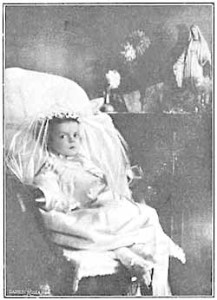Within the Crowd I Watched in Awe as the Priest Stepped into the Sandals of Christ
What follows is about a priest in a crowd, a famous poem, and a moment in time. The moment was like seeing a tiny flower growing out of a crack in a concrete sidewalk. That tiny flower is another example of God’s creative beauty that surrounds us yet is barely noticed by anyone. The fate of that tiny flower is ominous. Even though no person anywhere at any time could ever create that fragile, work of living beauty, it more than likely will be ignored, stepped upon or sprayed with weed killer to get rid of it. Ah well, we “smarties” have no time for such trivialities and petty annoyances.
The poem I refer to is “Trees” by Joyce Kilmer. Written in 1913, it has a timely message. There is a line in the poem that reads, “A tree that looks at God all day, And lifts her leafy arms to pray”: the tiny flower in the concrete is a smaller version, is it not? So what about the priest in the crowd?
I was at a parish event the other evening which featured as speakers our bishop, an author, a radio station personality, and our pastor. The Knights of Columbus (which included me) were the ones who prepared and served the free dinner to over 300 guests. The parish center was packed, and when the final speaker had finished we began to serve the dessert. I sensed something special was going on nearby. I do not know if anyone else but me was paying attention but I was about to witness one of those special moments in time.
There were a number of local parish priests in attendance and one of them was the chaplain at the local VA hospital. I was working in the kitchen, getting the cake plates on trays and handing the trays to those serving the guests. Outside the kitchen was the drink table where coffee, tea, cold drinks etc were available. At any given time there were at least ten people standing in line. Five feet away from the drink table was the first row of dinner tables. Father was sitting at the end of the first table talking to a woman.
At this point, the chatter was quite loud and people were up and moving about visiting other tables saying “Hi” to other folks they knew. I noticed Father looking at the young lady very intently and purposefully. I knew this priest had put his Jesus’ sandals on.
I kept working and watching the two of them. They were at least twenty feet away from me and, with all the activity and noise and people milling about and all around them, they had managed to be alone. The priest listened and listened and listened some more. I watched as best I could because this was so awe-inspiring. I was witnessing Christ do His thing through His priest. This happens every time we attend Mass, but how many of us think about what actually IS happening? We hear of this happening in other places, but how often do we get to watch it happen? Hardly ever.
After a while, Father leaned his head to the right a bit and rested his chin on his upraised fist. He was not looking directly at the woman; he was now sort of looking downward. He inconspicuously blessed her and, I assume, she was being given absolution. I was not positive because I had heard nothing and never even saw her face. But it did not matter. Whatever was happening between them was spiritual and beautiful.
Like the tiny flower popping its little lavender petal through a crack in concrete or Kilmer’s magnificent tree looking at God all day lifting its “leafy arms to pray,” this moment was those moments. Few people notice the stunning oak tree standing majestically alongside a roadway or a blade of grass pushing its way through a hairline crack in a slab of cement. Sadly, more and more people are losing sight of Christ in our midst and the hand of the Creator smiling down on His creations. I was blessed. I caught a glimpse the other night.
Joyce Kilmer’s poem finishes up with the poignant words: “Poems are made by fools like me, But only God can make a tree.”
We need to remember that.
Copyright 2017 Larry Peterson

![IMG_1225-L[1]](http://blog.catholicwritersguild.com/wp-content/uploads/2017/10/IMG_1225-L1-300x225.jpg)
![IMG_5706-L[1]](http://blog.catholicwritersguild.com/wp-content/uploads/2017/10/IMG_5706-L1-300x225.jpg)
![IMG_5766-L[1]](http://blog.catholicwritersguild.com/wp-content/uploads/2017/10/IMG_5766-L1-300x225.jpg)

